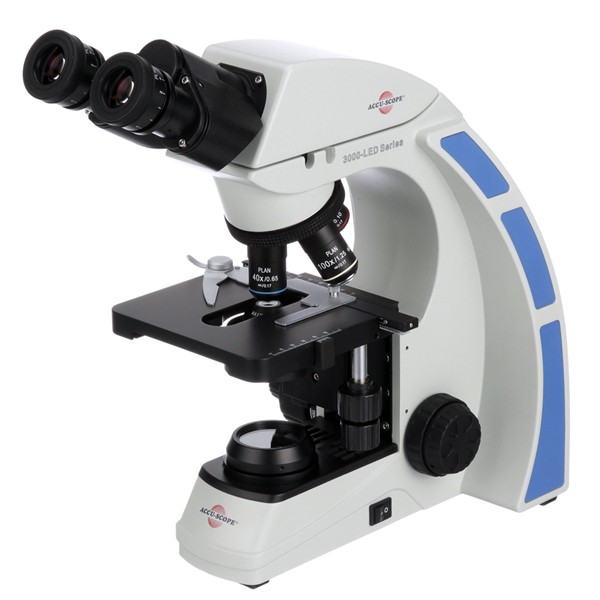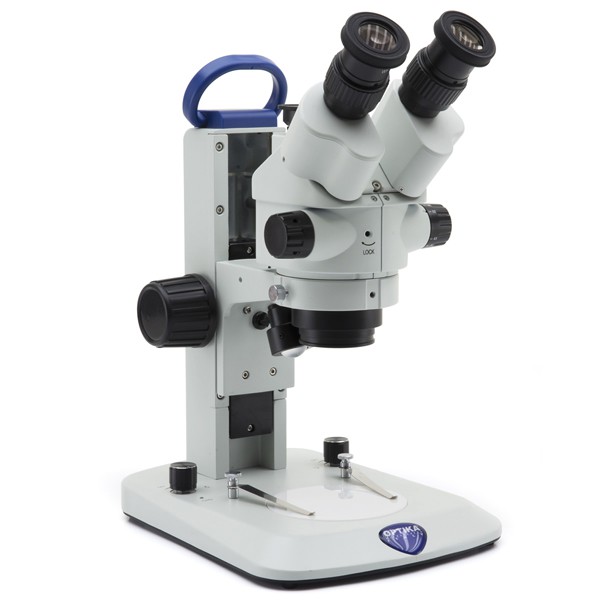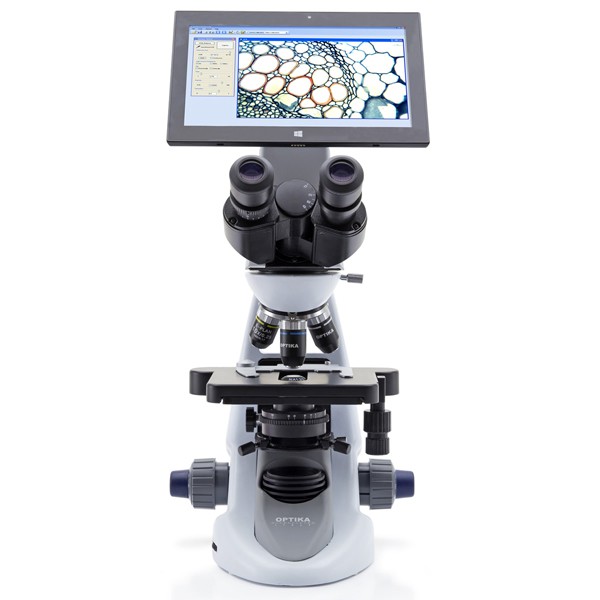Surfing the web to determine which microscope to buy can be an overwhelming process. Do I choose a compound microscope or stereo microscope? What magnification? How much should I spend? Would I choose a monocular microscope or binocular microscope? All of these questions will be answered in the steps below to figure out which microscope is right for you. Your application and budget are the 2 most important factors when selecting the ideal microscope to fulfill your needs. What you are viewing will determine the type of microscope your laboratory, school, or industry will require.
The two basic types of optical microscopes
Compound Microscopes

Compound Microscopes have two or more convex lenses that allow for a detailed study of your specimen in a two-dimensional image. Compound microscopes are available in both monocular and binocular formats. They have a number of objectives of varying magnifications mounted in a rotating nosepiece. Typically, the range of magnification on a compound microscope is between 40x and 1000x, although some are capable of lower or higher magnifications. Because only one objective is used at a time, the viewer will see a two-dimensional image of the specimen. Such uses include high magnification of internal structures of cells. For entry-level student microscope, check out our student microscopes section; for medical, laboratory and research refer to clinical & laboratory microscopes; included in the compound microscope or light microscopes are inverted microscopes, phase contrast microscopes, polarizing microscopes, fluorescence microscopes, and metallurgical microscopes. For specific applications such as veterinary, gemological, live blood cell analysis, asbestos, measuring, toolmaking, refer to our microscopes applications section.
Stereo Microscopes
Stereo Microscopes give the viewer an erect (upright and unreserved) stereoscopic (3-dimensional) image. This is particularly useful for biologists performing dissections, technicians repairing circuit boards, paleontologists cleaning and examining fossils or anyone who needs to work with their hands on small objects. Most stereo microscopes are used at magnifications from 5x to 50x. However, with the proper microscope and accessories, magnifications up to approaching 400x can be achieved. For educational and simple hobby use, refer to LED stereo microscopes. To customize and build a stereo microscopy system for industrial or advanced applications, refer to the stereo modular microscopes. This type of system will allow one to customize stands and illumination systems for any type of application. For Research Grade, we feature Common Main Objective stereo microscopes. These systems are designed for critical viewing for research, medical, forensic, inspection and other high-end stereo microscope uses.
Within each of these applications, however, there can be far more demanding requirements; a researcher studying the functions of neurons will require a far more sophisticated instrument than a high school biology teacher introducing students to cellular structures for the first time. If you have a very specific application, you may need a highly specialized microscope or special accessories. With our wide range of microscopes and accessories, we can help you configure the correct microscope you’re your specific needs.
If you wish to capture or display images, digital microscope and digital microscope cameras offer everything you need to accomplish these tasks.
Digital Microscopes
For many applications, the ability to capture, display, and preserve specimen images is of equal or greater importance than actually viewing the specimen through the eyepieces. Photomicrography (35mm cameras) has been a common option for decades, but the recent development of digital microscopes and digital microscope cameras has greatly increased both the popularity and flexibility of microscope imaging. The economical CMOS for everyday video capturing or the higher-priced CCD (closed capture device) for low light and higher resolution applications and digital eyepiece cameras connect to most eyepieces or ocular tubes. Instead of clicking through slides during a lecture, university professors can now display real-time video images on projection televisions; petroleum geologists can now e-mail images of core samples to their laboratories from remote locations around the world, and oncologists can refer to CD or on-line catalogs of cell images to help them make faster and more accurate diagnoses.
If your application calls for live viewing and projection to a TV-type monitor refer to video inspection microscopes. For digital imaging, please refer to digital microscope cameras and digital inspection microscopes. There are many different methods for capturing, displaying, and recording microscope images and each has its own advantages and disadvantages. It would be impossible to cover all of these options here, but one basic piece of information will be important in selecting your microscope: while it is possible to mount a camera on a monocular or binocular microscope (note: a binocular microscope has two eyepieces, but is not necessarily a stereo microscope), it is far better to use a trinocular microscope designed for camera work. Trinocular models have two eyepieces for normal viewing, plus a third phototube on which you can mount a camera without interfering with the normal operation of the microscope. Trinocular microscopes are ideal for photo, digital or video applications.
Remember, depending upon your application additional components are required on your microscope depending upon your use. Hopefully, this brief outline will help you to determine which kind of microscope your application requires.
If you would like further information on any of these topics, or if you would like help in selecting the right microscope for your application, simply contact us at any time or call toll-free at 877-877 7274 and our friendly microscope experts will be glad to assist.


